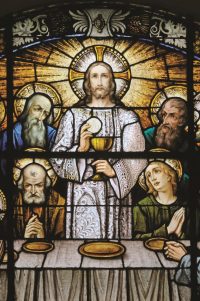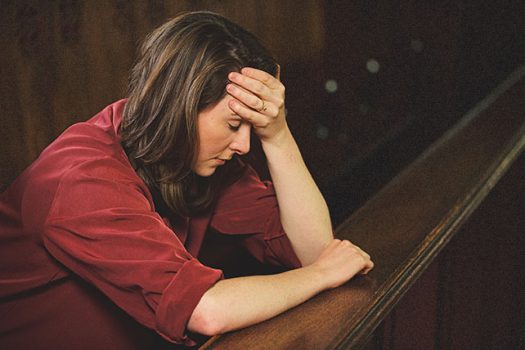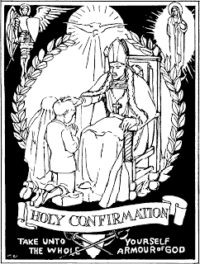Real Presence Tractate IV
 REAL PRESENCE
REAL PRESENCE
An “apologia” for the Traditional Catholic Doctrine that the bread and wine of the Holy Eucharist become the real, objective Body and Blood of our Lord Jesus Christ.
The Rev’d. Stephan W. Heimann
Not long after our Lord Jesus fed five thousand people, the account of which takes up the opening verses of John 6, He had a conversation with some of His followers, in which He said the following:
Verily, Verily, I say unto you, except you eat the flesh of the Son of Man and drink His blood, you have not life in yourselves. He that eateth my flesh and drinketh My blood hath eternal life, and I will raise Him up on the last day… He that eateth My flesh and drinketh My blood abideth in Me and I in Him.
This statement, along with the institution narrative in the Gospel accounts of Matthew, Mark, and Luke, as well as the one found in 1Corinthians 11, led to a very early and abiding belief in what is called the Real Presence of Christ in the elements of bread and wine – that these common elements, when consecrated, become the sacramental Body and Blood of Jesus Christ and that we receive Him (Body, Blood, Humanity, and Divinity) when we receive Holy Communion.
The writers of the early Church reaffirmed this belief in their writings. St. Ignatius of Antioch declared that “the Eucharist is the flesh of our Savior Jesus Christ, which suffered for our sins and which the Father in His goodness raised.”
St. Gregory of Nyssa, writing in the fourth century, declared “the bread sanctified by the Word of God we believe to be transmitted into the Body of God the Word.
St. Ambrose, a contemporary of St. Gregory, wrote, “And whenever we receive the sacrament which is transfigured through the mystery of holy prayer into flesh and blood, we show forth the Lord’s death. We have seen the High Priest coming to us, we have seen and heard Him offering His Blood for us. We follow as we are able, we priests, in offering sacrifice for the people.”
Tertullian, St. Cyprian and St. Augustine and numerous other patristic writers likewise all stated a belief in the objective Real Presence of the Body and Blood of Christ in the consecrated elements of Eucharistic bread and wine. The earliest liturgies of the Christian Church contain language which indicates a clear belief that the bread and wine were transformed into the Body and Blood of Jesus Christ at some point during the Prayer of Consecration.
In the thirteenth century, however, the Roman Catholic Church did something which was later to become a source of much controversy and dispute regarding the nature of that Real Presence. The Fourth Lateran Council propagated the dogma (unquestionable belief) of transubstantiation, based on a mixture of Christian doctrine and Aristotelian logic. That dogma states that the bread and wine are, after the Prayer of Consecration, only bread and wine in appearance, the natural “accidents” of created substance. Their true substance, has in fact, been transformed into the Body and Blood of Jesus Christ. Although this continued the patristic teaching that Christ was truly present in the bread and wine, it added something which the patristic writers never intended and never said.
It was to repudiate this teaching of transubstantiation and to correct certain “abuses” – some real and some imagined – of the medieval Church that various reformers began to “dabble” in Eucharistic Theology, and often write their own.
One school of thought (principally Lutheran) advanced the theory of consubstantiation – that the Body of Blood of Christ were somehow “alongside” the elements of bread and wine, although not contained within them. John Calvin advanced the theory known as “receptionism” which stated that those who “worthily” receive Holy Communion (one is not sure whether that “worthiness” stemmed from proper self-examination and contrition or simply being one of the “predestined elect”) received the Body and Blood of Christ; those who were not so prepared did not. This theory is the one most explicitly contained within the Thirty-Nine Articles of Religion. Calvin rejected out of hand any theory that would change the nature or substance of the bread and wine itself, and both the Lutheran and Calvinist theories rejected any notion that would have the elements remaining the Body and Blood of Christ after the Holy Communion service was completed.
Enter Zwingli into this fray, and one has the theory of “Memorialism,” which persist today among most the evangelical and fundamentalist Protestant sects. This theory rejects completely any notion that we receive anything but bread and wine in the Holy Communion. It would have us believe that all we do when we celebrate the Holy Communion is recall to memory the Mighty Acts of Redemption of our Lord Jesus Christ. “Eating His flesh and drinking His blood” become, for the memorialist, simply recalling with thankfulness His redeeming work, and accepting Him as the sacrifice for sins.
Obviously, these theories have no backing in the true meaning of the Gospels or in the writings of the Fathers. They are simply poor human attempts to compensate for, to an extreme measure, what were perceived medieval errors about the Eucharist. It is an obvious case of trying to propagate the theory that “two wrongs, if they are diametrically opposed to each other, make a right.”
True Catholic-minded Anglicans have always believed in the objective Real Presence of Christ in the Eucharist. One of the earliest was none less than the Queen Elizabeth I, who responded to the disputations about the nature of the change in Eucharistic elements saying:
His was the mouth that spake it;
His were the hands that brake it;
And whatever that doth make;
I, in faith, do take it.
Like the Eastern Church, Anglicans do not try to specify exactly how the bread and wine become the Body and Blood of Christ, and what the exact nature of that Real Presence is. We simply affirm that the Eucharistic elements are the real and objective Body and Blood of Jesus.
In the nineteenth century, wirters like John Keble and E.B. Pusey in England, and James DeKoven and Charles Gafton in the United States helped advance the true orthodox notion of the objective Real Presence in the Eucharistic elements. The English writers in particular, spoke lovingly of the nourishment, comfort, and strength that was received by the faithful communicant when consuming the Body and Blood of Christ.
Some of the American writers were as concerned about promoting devotion to our Lord in the Blessed Sacrament as they were about the benefits of faithful reception. If, they said, Christ is truly present in the elements of bread and wine, then His Presence, like that in Heaven, is worthy of worship and adoration. Extramural services of devotion to our Lord in the Blessed Sacrament became a frequent practice among some Anglo-Catholics of the late nineteenth and twentieth century.
While this author is of the firm belief in the validity and value of such devotions, he is also convinced that straying away from the rock solid principle of objective Real Presence in the elements, which is the blessing and benefit of all faithful communicants, only complicates matters and raises old prejudices and fears anew. It is perhaps better to follow on core doctrine, which sometimes has become hard enough to defend, and leave the matter of devotional outgrowth to private reverence and parochial authority.
One further note must be raised on the various theories about Real Presence. A new one seems to have raised its head recently – that “Real Presence” means that Christ is present with us during the Liturgy of the Holy Eucharist. It would seem that this is somewhat in harmony with recent Lutheran practice of hanging a Sanctuary Light in the Church even though there is no Sacrament reserved. True enough, Christ is Present in the celebration of the Holy Eucharist, as He is in the midst of “two or three gathered together in His Name.” This is not, however, what is meant by Real Presence, and cannot be allowed to stand as a sufficient definition of Real Presence. Nothing less than the belief in the mystical transformation of the bread and wine into the Sacramental Body and Blood of Jesus Christ will suffice for faithful Anglicans!






